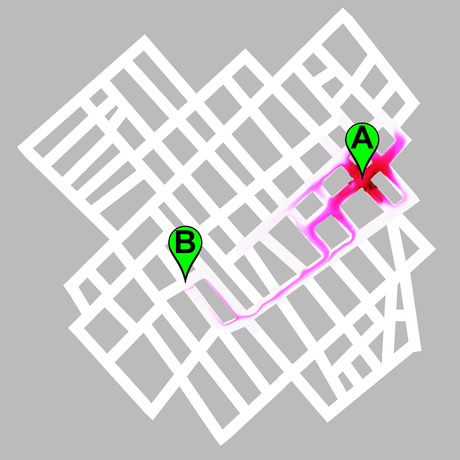Chemical computing faster than satnav

Scientists from Swiss Federal Laboratories for Materials Science and Technology (Empa) have developed a chemical alternative to GPS, which they claim will change the future of transport planning and logistics.
The team from Empa joined forces with scientists from Hungary, Japan and Scotland to develop a chemical ‘processor’ that reliably detected the fastest way through a city maze. The process takes advantage of the laws of physical chemistry and practices what is called ‘chemical computing’. A gel mixed with acid is applied to the exit of a labyrinth (the destination), while the rest of the maze is filled with an alkaline liquid. While the acid spreads through the alkaline maze, the majority of it remains with the gel at the exit point. An alkaline solution mixed with dye is then added to the other end of the maze (the entrance) and it then automatically seeks the way to the exit, or the point with the highest acidity level.
The process is an example of what is known as the Marangoni effect, which works because acid distributed in the maze reacts with the newly added dyed alkaline solution. The dyed solution is repelled by the mixture of alkaline and acid and pushed to the source of acidity at the exit. The dye enables the team to see the path taken, which is generally the shortest path, although it also simultaneously takes alternative routes. These alternative paths typically feature a considerably lower probability, so the dye trace is weaker.

Rita Tóth, from Empa’s Laboratory for High Performance Ceramics, explains the benefit of this process: “The advantage of this chemical computer over its electronic counterpart is that it finds all the possible routes virtually in parallel. A normal computer calculates step by step one possibility after another, which takes longer.” Basically, traditional satnav systems demand a tremendous amount of computational power to achieve the same goal.
Given that the test object was only a few square centimetres in size, the research team is now trialling larger and more complex mazes using real-world scenarios, such as finding a pizza restaurant in a Budapest neighbourhood. While still in the early stages of development, it is envisaged that potential applications include experimental psychology, network and graph theory, robotics and transport planning.
The study has been featured in Langmuir, a peer-reviewed scientific journal published by the American Chemical Society.
All-electric haulage fleet under mining alliance
A strategic alliance between Newmont and Caterpillar will see the rapid deployment of an...
How to measure ROI of field service management software
Some ROIs are easier to calculate than others. It's important to consider both tangible and...
Preparing the grid for electric vehicles
A new $3.4 million trial will help support growing adoption of electric vehicles across Australia...




